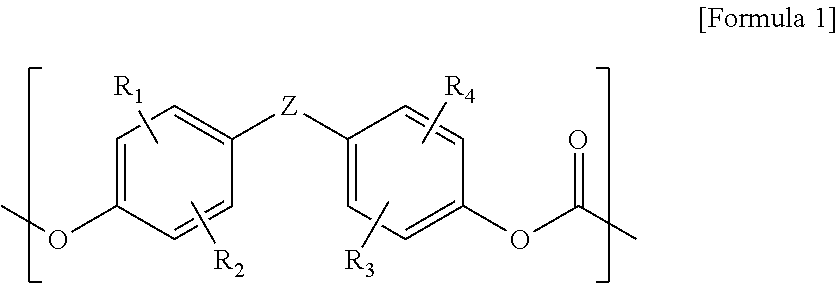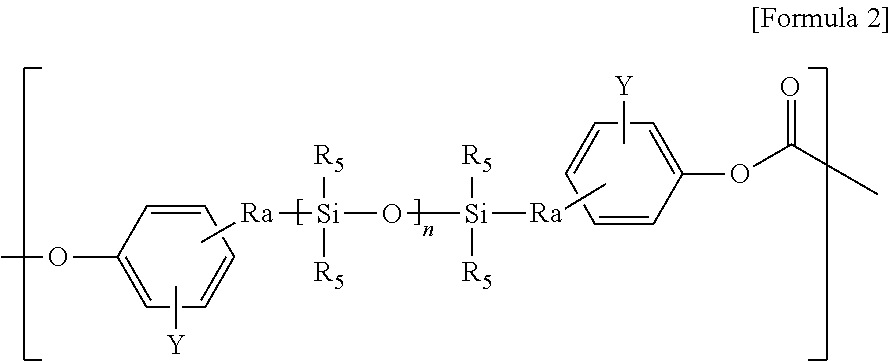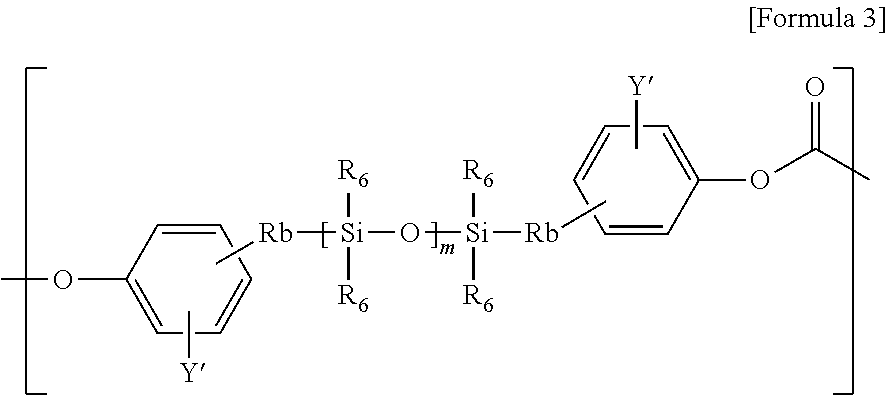Copolycarbonate and composition comprising the same
a technology applied in the field of copolycarbonate and composition comprising the same, can solve the problems of high production cost, chemical resistance or impact strength, and conversely reduced melt index, and achieve the effect of improving impact strength and impact strength
- Summary
- Abstract
- Description
- Claims
- Application Information
AI Technical Summary
Benefits of technology
Problems solved by technology
Method used
Image
Examples
preparation example 1
Production of Polyorganosiloxane (Eu-30)
[0096]
[0097]42.5 g (142.8 mmol) of octamethylcyclotetrasiloxane and 2.26 g (16.8 mmol) of tetramethyldisiloxane were mixed. The mixture was then placed in 3 L flask together with 1 part by weight of an acid clay (DC-A3) compared to 100 parts by weight of octamethylcyclotetrasiloxane, and reacted at 60° C. for 4 hours. After completion of the reaction, the reaction product was diluted with ethyl acetate and quickly filtered using a celite. The repeating unit (n) of the unmodified polyorganosiloxane thus prepared was confirmed through 1H NMR and the result was 30.
[0098]In the resulting terminal-unmodified polyorganosiloxane, 11.7 g (71.3 mmol) of eugenol and 0.01 g (50 ppm) of Karstedt's platinum catalyst were introduced and reacted at 90° C. for 3 hours. After completion of the reaction, the unreacted polyorganosiloxane was removed by conducting the evaporation under the conditions of 120° C. and 1 torr. The terminal-modified polyorganosiloxane...
preparation example 2
Preparation of Polyorganosiloxane (Eu-60)
[0099]
[0100]57.5 g (193.2 mmol) of octamethylcyclotetrasiloxane and 2.26 g (16.8 mmol) of tetramethyldisiloxane were mixed. The mixture was then introduced in 3 L flask together with 1 part by weight of an acid clay (DC-A3) compared to 100 parts by weight of octamethylcyclotetrasiloxane, and reacted at 60° C. for 4 hours. After completion of the reaction, the reaction product was diluted with ethyl acetate and quickly filtered using a celite. The repeating unit (n) of the unmodified polyorganosiloxane thus prepared was confirmed through 1H NMR and the result was 60.
[0101]In the resulting terminal-unmodified polyorganosiloxane, 8.7 g of eugenol and 0.01 g (50 ppm) of Karstedt's platinum catalyst were introduced and reacted at 90° C. for 3 hours. After completion of the reaction, the unreacted polyorganosiloxane was removed by conducting the evaporation under the conditions of 120° C. and 1 torr. The terminal-modified polyorganosiloxane thus pr...
preparation example 3
Preparation of Polycarbonate
[0102]978.4 g of Bisphenol A (BPA), 1,620 g of NaOH 32% aqueous solution, and 7,500 g of distilled water were introduced in 20 L glass reactor. After confirming that BPA was completely dissolved in a nitrogen atmosphere, 3,670 g of methylene chloride and 18.3 g of p-tert-butylphenol were introduced and mixed. To this mixture, 3,850 g of methylene chloride in which 542.5 g of triphosgene was dissolved was added dropwise for one hour. At this time, a NaOH aqueous solution was maintained at pH 12. After completion of the dropwise addition, the reaction product was aged for 15 minutes, and 195.7 g of triethylamine was dissolved in methylene chloride and introduced. After 10 minutes, pH was adjusted to 3 with a 1 N aqueous hydrochloric acid solution and then washed three times with distilled water. Subsequently, the methylene chloride phase was separated, and then precipitated in methanol to give a polycarbonate resin in the form of a powder. The molecular wei...
PUM
| Property | Measurement | Unit |
|---|---|---|
| temperature | aaaaa | aaaaa |
| temperature | aaaaa | aaaaa |
| reaction temperature | aaaaa | aaaaa |
Abstract
Description
Claims
Application Information
 Login to View More
Login to View More - R&D
- Intellectual Property
- Life Sciences
- Materials
- Tech Scout
- Unparalleled Data Quality
- Higher Quality Content
- 60% Fewer Hallucinations
Browse by: Latest US Patents, China's latest patents, Technical Efficacy Thesaurus, Application Domain, Technology Topic, Popular Technical Reports.
© 2025 PatSnap. All rights reserved.Legal|Privacy policy|Modern Slavery Act Transparency Statement|Sitemap|About US| Contact US: help@patsnap.com



